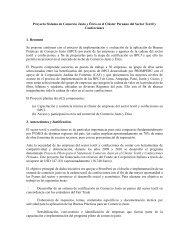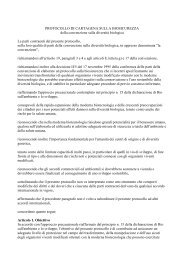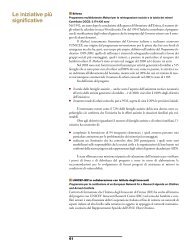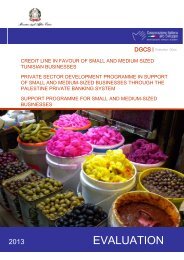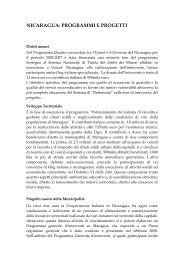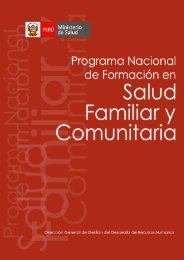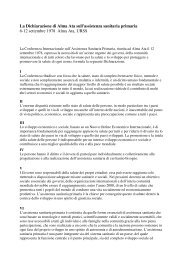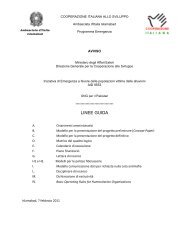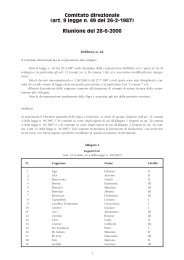If the accused claims to not knowing the age of the person offended (not beinga regulation, such as Art. 609 sexies, that for acts of sexual violence excludes t<strong>here</strong>levance of ignorance of the age of the offended) the general regulations foreseenfor the accusation of the circumstances are applied, hence to impose theaggravating circumstances foreseen by Art. 600 sexies on the accused, who shouldat least have had the possibility of realising that the minor was under fourteenyears.The most innovative aspect, with respect to the entire preceding regulations iscertainly represented by the second paragraph which introduces for the first time inthe legal system, the punishment for the beneficiary of paid sexual services of aminor. This prevision was introduced on the assumption that t<strong>here</strong> exists acontinuum between the client and the exploiter inasmuch as both, even having verydifferent roles, enter into the same circuit of demand and offer which is at thecentre of the offence against a minor.The provision punishes with an alternative sentence the client of “a minor of anage of between fourteen and sixteen years” 95 , unless the fact constitutes a moreserious offence. The protecting clause is that if the fact is committed by anascendant, even an adopting parent, a tutor or other person for reasons of care,education, instruction, guard or custody the minor is entrusted to, or who has arelationship of living with the minor, then the more serious prevision of Art. 609quater paragraph 1 No. 2 Penal Code is considered.Recently, Parliament approved Law No. 228 of 11 August 2003, whichintroduces some interesting modifications to the framework of regulationsconcerning the trafficking of human beings.The crime of reduction to slavery foreseen under Article 600 of the Penal Codeis modified, describing in detail the activities punished, and above all adapting t<strong>here</strong>gulation to the new forms of slavery characterised by the trade and trafficking ofpersons.The regulation sanctions the behaviour of those who: exercise powers over a person corresponding to those of property rights; reduction or maintenance of a person in a state of continuous subjection,forcing them to provide sexual services, or to beg, or whatsoever services thatcomprise exploitation.The reduction or maintenance in a state of subjection takes place when theconduct is carried out: through violence, threats, deception, abuse of authority, profiting from asituation of physical or psychological inferiority, or from a situation ofnecessity; through promises, or giving sums of money or other advantages to those whohave authority over the person.Beside the work of re-styling Article 600 of the Penal Code, the legislatorradically modifies the juridical case contained in Article 601 of the Penal Code -95It should be remembered that on the basis of the law on sexual violence (l. No. 66/1996) to performsexual acts with a minor of below 14 years is always considered sexual violence.
which previously punished the trade and commerce of slaves or persons and, in thesecond paragraph, the trade and commerce of minors in order to induce them toprostitution - transforming it into a crime which punishes: trafficking of persons (minors or not) who are found in conditions of slaveryor bondage, as described in Article 600 of the Penal Code; induction or forcing, through violence, threats, abuse of authority or profitingfrom a situation of physical or psychological inferiority or from a situation ofnecessity, or through promises or giving sums of money or other advantagesto the person who holds authority over the person - to permit entry or to stayor to leave State territory, or transfer the person within the State, with the aimof committing crimes of reduction or maintenance in slavery or bondage.The new disposition is not t<strong>here</strong>fore limited to punishing the behaviour oftrafficking with the aim of exploitation of prostitution but is enlarged to every typeof behaviour, considering however - analogically that which is foreseen underArticle 600 of the Penal Code - the minor age of the victim, the objective ofexploitation for prostitution or for extracting organs, as hypotheses of aggravationof the basic punishment. The basic punishment of imprisonment from 8 to 20 yearsmay be increased by one third to one half in this last hypotheses.Analogous sanctions are established even for the hypothesis of acquiring andalienation of slaves under Article 602 of the Penal Code.Of not minor importance as well is the introduction of associative behaviourdirected towards committing one of the crimes foreseen under Articles, 600, 601and 602 as a specific prevision and aggravated by Article 416 of the Penal Code.On the trial side it is established that the competence for these crimes passesfrom the Court of Assizes to the Tribunal of a collegial composition and that thepublic prosecutor in charge of the investigations will be the prosecutor of theRepublic of the district court, analogically to that which occurs for crimes related toorganised crime.For the new criminal juridical cases, the practice of under cover investigativeactivities and wider amplitude of cases for which telephonic interception may beundertaken is <strong>allo</strong>wed.Moreover, the public prosecutor is permitted to delay the emission of libertyrestriction measures and of those of seizure if it is proved necessary to acquiresubstantial elements of proof, or the identification or capture of those responsible.Identical powers are given to the officials of the judicial police for provisions undertheir responsibility.Finally, the preliminary investigations are of a longer duration which can beprotracted up to 2 years for the new crimes introduced under the Law.b) The co-presence of deflationary trial mechanisms and penal andpenitentiary prizesFrequently the result in terms of sanctions inflicted in trials relating to thetraffic of persons for sexual exploitation “leaves a bad taste in the mouth”: evenwithout measuring the efficacy of a penal system in terms of major or minor
- Page 1:
TRAFFICKINGOF NIGERIAN GIRLSTO ITAL
- Page 5 and 6:
F O R E W O R D1. Objectives and st
- Page 7 and 8:
and who have identified the most si
- Page 9 and 10:
on the other hand, for those involv
- Page 11:
Case files analysed: Preventive det
- Page 15 and 16:
Table 2 - Socio-economic situation
- Page 17 and 18:
Table 3 - Nigerian citizens regular
- Page 19 and 20:
Table 5 - Social protection permiss
- Page 21 and 22:
Table 7 - Number of persons charged
- Page 23 and 24:
Table 8 - Detainee population sub-d
- Page 25 and 26:
and the United States enables this
- Page 27 and 28:
C H A P T E R IW a y s a n d p h a
- Page 29 and 30:
Figure No.2 - Edo State.It is not c
- Page 31 and 32:
Nigeria. From 1996 in Benin City an
- Page 33 and 34:
In this variegated framework, the d
- Page 36:
“Benin City is one of those State
- Page 39 and 40:
Various privileged witnesses of the
- Page 41 and 42:
In the first years of the traffic o
- Page 43 and 44:
pay considerable sums for lodging,
- Page 45 and 46:
The routesWe find at least three ty
- Page 47 and 48:
Figure No.5 - Trafficking routes th
- Page 49 and 50:
The journey overland through Africa
- Page 51 and 52:
new dispositions and contacts to co
- Page 53 and 54:
Then he sends her in a taxi to the
- Page 55 and 56:
T. remains in this house for 21 day
- Page 57 and 58:
detainees go towards the refectory,
- Page 59 and 60:
At this point the organisation esco
- Page 61 and 62:
was accepted by the Ivory Coast pol
- Page 63 and 64:
B.E. «Yes, I was given a Ghanaian
- Page 65 and 66:
Now the documents are “hired”:
- Page 67 and 68:
It is understood however that the v
- Page 69 and 70:
“There is no Nigerian passport wh
- Page 72 and 73:
C H A P T E R I VL i v i n g a n d
- Page 74 and 75:
have no shop and then there is no p
- Page 76 and 77:
The cost to manage the house and th
- Page 78 and 79:
mine since a long time, he can’t
- Page 80 and 81:
A feminine managementIn analysing t
- Page 82 and 83:
“There are many pimps that when y
- Page 84 and 85: The control of movementThe fact tha
- Page 86 and 87: Physical punishments can be made by
- Page 88 and 89: Control between psychological subje
- Page 90 and 91: arms), tortured in many different f
- Page 92 and 93: C H A P T E R VT h e o r g a n i s
- Page 94 and 95: Each penal procedure on the subject
- Page 96 and 97: Often it is the same madam who move
- Page 98 and 99: Even in numerous recent criminal pr
- Page 100 and 101: work arrangements (…) persons tha
- Page 102 and 103: man all the money she had in the ho
- Page 104 and 105: in the plates and everything and th
- Page 106 and 107: exploitation) has reached an amount
- Page 108 and 109: C H A P T E R V IT h e e n d o f t
- Page 110 and 111: A: «You have to bring me a present
- Page 112 and 113: Often the family is however not abl
- Page 114 and 115: the different evaluations of the as
- Page 116 and 117: The discussions on the possibility
- Page 118 and 119: eal results: to distance herself fr
- Page 120 and 121: of a different culture is very impo
- Page 122 and 123: C H A P T E R V I IC o n s i d e r
- Page 124 and 125: In the case of the girls having mor
- Page 126 and 127: As has been many times noted, the c
- Page 128 and 129: under the profile of the “quality
- Page 130 and 131: person to obtain either relevant re
- Page 132 and 133: Numerous are the criminal juridical
- Page 136 and 137: sanctions, sometimes, also in prese
- Page 138 and 139: d) Investigative and judiciary co-o
- Page 140 and 141: The reform foresees, under Art. 1,
- Page 142 and 143: which the woman can definitively tu
- Page 144 and 145: witnesses, social operators - agree
- Page 146: and necessary, therefore, to think
- Page 149 and 150: in many cases they are driven to th
- Page 151 and 152: Melossi, D., (2002), “Le teorie s





